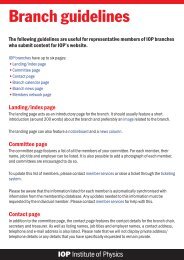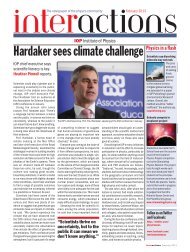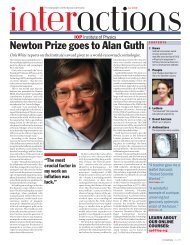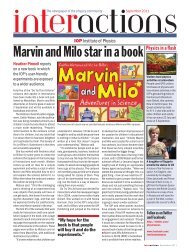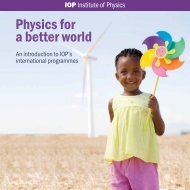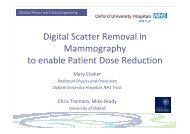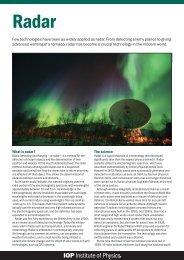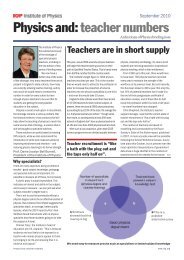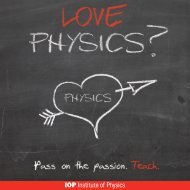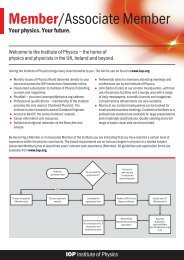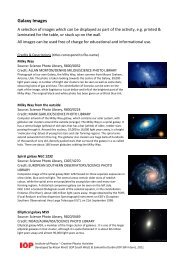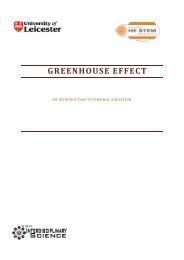Girls in the Physics Classroom: A Teachers' Guide - Institute of Physics
Girls in the Physics Classroom: A Teachers' Guide - Institute of Physics
Girls in the Physics Classroom: A Teachers' Guide - Institute of Physics
You also want an ePaper? Increase the reach of your titles
YUMPU automatically turns print PDFs into web optimized ePapers that Google loves.
1: Lessons from effective classroom practice<br />
3. Data provided by OFSTED<br />
Research and Analysis Division<br />
(appendix 4.1).<br />
4. Some had experienced recent<br />
decl<strong>in</strong>e consistent with <strong>the</strong> overall<br />
reduction <strong>in</strong> AS entries.<br />
4<br />
1: Lessons from effective classroom<br />
practice<br />
The author <strong>of</strong> this section, Bob Ponchaud, was an HMI for<br />
13 years and a specialist adviser for science to OFSTED for<br />
eight years.<br />
The evidence that this section is based on comes from<br />
visits to schools <strong>in</strong> England where <strong>the</strong> take-up <strong>of</strong> physics<br />
by girls is relatively high. Key Stage 4 (KS4) and post-16<br />
lessons were observed to ga<strong>in</strong> an <strong>in</strong>sight <strong>in</strong>to <strong>the</strong> context<br />
<strong>in</strong> which decisions about fur<strong>the</strong>r studies are made and <strong>in</strong>to<br />
<strong>the</strong> reality <strong>of</strong> classroom experience <strong>the</strong>reafter. The result<strong>in</strong>g<br />
evidence is necessarily anecdotal but draws on his long<br />
experience <strong>of</strong> classroom observation.<br />
The research confirms that <strong>the</strong> best s<strong>in</strong>gle-sex schools are<br />
much more successful than mixed schools at gett<strong>in</strong>g girls<br />
to study physics post-16. Different levels <strong>of</strong> resource and<br />
type <strong>of</strong> <strong>in</strong>take are a factor. Never<strong>the</strong>less, features <strong>of</strong> <strong>the</strong><br />
ethos, organisation and pedagogy <strong>of</strong> <strong>the</strong>se top s<strong>in</strong>gle-sex<br />
schools that lead to <strong>the</strong>ir success can be transferred to<br />
mixed schools. The adoption <strong>of</strong> <strong>the</strong>se features is already<br />
contribut<strong>in</strong>g to improved engagement and take-up <strong>in</strong> <strong>the</strong><br />
schools that were visited for Ponchaud’s research.<br />
Some schools are much more successful than o<strong>the</strong>rs at<br />
recruit<strong>in</strong>g girls <strong>in</strong>to physics, as is revealed by <strong>in</strong>formation<br />
held on <strong>the</strong> OFSTED database. 3 Only 80 schools from a<br />
sample <strong>of</strong> 1500 recruited 10% or more <strong>of</strong> <strong>the</strong>ir post-16 girl<br />
cohort to take physics <strong>in</strong> 2003. Of <strong>the</strong>se schools, 44 were<br />
girls’ schools and 36 <strong>of</strong> <strong>the</strong>m selected by atta<strong>in</strong>ment. A fur<strong>the</strong>r<br />
10 out <strong>of</strong> <strong>the</strong> 80 had more than 20% <strong>of</strong> <strong>the</strong>ir cohort<br />
tak<strong>in</strong>g physics. These 44 schools contributed almost onequarter<br />
<strong>of</strong> <strong>the</strong> total A-level physics entries for <strong>the</strong> sample.<br />
Research suggests that, once socioeconomic factors and<br />
prior atta<strong>in</strong>ment have been allowed for, <strong>the</strong> situation is<br />
much less stark. However, many lessons can be learned<br />
from those schools that are highly successful.<br />
The schools that were visited as part <strong>of</strong> this project had all<br />
succeeded <strong>in</strong> recruit<strong>in</strong>g girls <strong>in</strong>to AS-level physics, reta<strong>in</strong><strong>in</strong>g<br />
<strong>the</strong>m <strong>in</strong>to A2 and ga<strong>in</strong><strong>in</strong>g good exam<strong>in</strong>ation results. 4<br />
The aim was to identify, by observation and <strong>in</strong>terview, features<br />
<strong>of</strong> <strong>the</strong> organisation and its teach<strong>in</strong>g <strong>of</strong> physics that<br />
might account for this relative success and that could be<br />
replicated elsewhere. Observation and <strong>in</strong>terview protocols<br />
were used but it is not suggested that this project constitutes<br />
rigorous research or that causal connections can be<br />
supported by anyth<strong>in</strong>g o<strong>the</strong>r than <strong>the</strong> author’s pr<strong>of</strong>essional<br />
judgement.<br />
1.1 The school culture and ethos<br />
What is it about some schools that makes <strong>the</strong>m so<br />
successful at recruit<strong>in</strong>g girls <strong>in</strong>to physics and is this<br />
quality transferable?<br />
The schools visited dur<strong>in</strong>g <strong>the</strong> survey had a number <strong>of</strong> common<br />
features that were reflected <strong>in</strong> <strong>the</strong> classroom and <strong>in</strong><br />
students’ responses dur<strong>in</strong>g <strong>in</strong>terview. The most successful<br />
girls’ schools had a strong “can-do” culture, which stimulated<br />
student self-belief. No teachers or students <strong>in</strong> <strong>the</strong>se<br />
schools made any mention <strong>of</strong> <strong>the</strong> commonly perceived difficulty<br />
<strong>of</strong> physics as a subject. Conversely, <strong>in</strong> mixed schools<br />
difficulty was <strong>of</strong>ten cited as a reason why students, particularly<br />
girls, did not choose physics. Teachers <strong>in</strong> <strong>the</strong> successful<br />
schools were not unrealistic about <strong>the</strong> demands <strong>of</strong><br />
some topics but <strong>the</strong>y viewed <strong>the</strong>se as a challenge to be met<br />
by staff and students. Some students regarded this challenge<br />
as part <strong>of</strong> <strong>the</strong> appeal <strong>of</strong> physics. One said:<br />
“You have to work at it but you get a buzz when<br />
you feel you understand a new idea. I don’t get<br />
that <strong>in</strong> o<strong>the</strong>r subjects.”<br />
It is unlikely that this can-do culture can be established<br />
quickly or that it is peculiar to physics, but it has a powerful<br />
effect on student choice.<br />
The successful schools had also reduced students’ and<br />
teachers’ subjection to gender stereotyp<strong>in</strong>g. Discussions<br />
with students showed that many <strong>of</strong> <strong>the</strong>m were ei<strong>the</strong>r<br />
unaware that physics was <strong>of</strong>ten regarded as a boys’ subject<br />
or discounted this view as out <strong>of</strong> date or irrelevant. <strong>Girls</strong><br />
<strong>in</strong> one s<strong>in</strong>gle-sex school commented:<br />
“No one has ever told us we can’t do physics or<br />
any o<strong>the</strong>r subject. People <strong>the</strong>se days can<br />
choose what <strong>the</strong>y want to do.”<br />
Some girls <strong>in</strong>dicated that <strong>the</strong>y had not much liked<br />
physics <strong>in</strong> <strong>the</strong> early years <strong>of</strong> secondary education and probably<br />
saw it as be<strong>in</strong>g more for boys. However, this view had<br />
changed as a result <strong>of</strong> a consistently good experience <strong>of</strong><br />
<strong>the</strong> subject. Ano<strong>the</strong>r major factor was career aspiration,<br />
particularly <strong>in</strong> <strong>the</strong> medical or paramedical fields. <strong>Physics</strong><br />
was viewed as a highly desirable, if not strictly necessary,<br />
subject for enter<strong>in</strong>g <strong>the</strong>se pr<strong>of</strong>essions, which students commonly<br />
regarded as fields <strong>in</strong> which women could excel.<br />
One <strong>of</strong> <strong>the</strong> strong similarities that emerged between girls<br />
and mixed groups visited dur<strong>in</strong>g <strong>the</strong> survey was girls’ preference<br />
for a collaborative ra<strong>the</strong>r than a competitive<br />
approach. Even <strong>the</strong> most able and confident female students<br />
would <strong>of</strong>ten preface <strong>the</strong>ir response to a question with<br />
an expression <strong>of</strong> uncerta<strong>in</strong>ty, reflect<strong>in</strong>g not <strong>the</strong>ir own doubt<br />
but <strong>the</strong> recognition that o<strong>the</strong>r members <strong>of</strong> <strong>the</strong> group might<br />
have an equally valid po<strong>in</strong>t <strong>of</strong> view. <strong>Girls</strong>-only classes were<br />
far less <strong>of</strong>ten dom<strong>in</strong>ated by an <strong>in</strong>dividual or a m<strong>in</strong>ority than<br />
<strong>in</strong> <strong>the</strong> case <strong>of</strong> mixed groups. Group activities, such as discussion<br />
or presentations, were also well liked by <strong>the</strong>m.<br />
The number <strong>of</strong> students tak<strong>in</strong>g A-level physics <strong>in</strong> mixed<br />
schools <strong>of</strong>ten fluctuates more than <strong>the</strong> take-up <strong>in</strong> girls’<br />
schools. Teachers, particularly those <strong>in</strong> mixed schools,<br />
I NSTITUTE OF P HYSICS R EPORT G IRLS IN THE P HYSICS C LASSROOM: A TEACHERS’ GUIDE FOR A CTION D ECEMBER 2006



